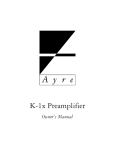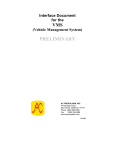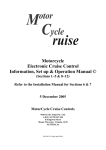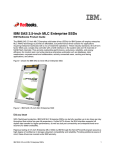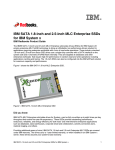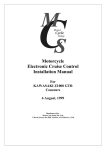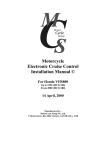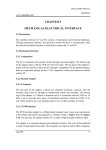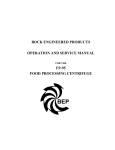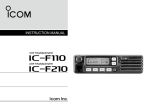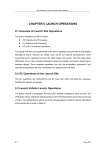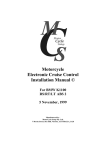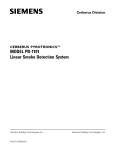Download honda vfr800 1998~2001 - Electronic Cruise Controls
Transcript
otor M C Cycle ruise Motorcycle Electronic Cruise Control Installation Manual © For Honda VFR800 Interceptor 1998~2001 (low exhaust model) 14 July 2005 MotorCycle Cruise Controls MotorCycle Setup Pty. Ltd. A.B.N. 94 798 167 654 6 Kingston Street Mount Waverley, Victoria, 3149 AUSTRALIA Honda VFR800 – 1998~2001 © NOTE: - This installation manual is an amended version of our old installation manual for a cruise control kit that used an earlier cruise control computer (electronics module). The new computer supplied in this kit is functionally superior to the old model. It also has more resistance to interference from electrical ‘noise’ and electromagnetic radiation and has all of our latest safety features built in. It is also a sealed unit making it much more suitable for motorcycle applications. It is however slightly different to the old model, so it is important to be careful of any small changes to the wiring system for the new model versus the old. We have edited the instruction set to some degree and added notes where obvious variations apply, but there still may be small anomalies in some cases. The other issue that may cause problems is the mounting of the new computer. It is slightly larger and much heavier than the old model. As a result it may not be possible to mount the new computer in the same location as the old one. The wiring harness supplied is long enough to allow you to mount the computer at any suitable location. It is important that do not mount the computer or run wiring next ignition coils or spark plug leads, and it is recommended that you do fit these parts as far away as possible from high current devices such as alternator wiring and voltage regulators etc. It is also important not to mount the computer too close to exhaust components or in a direct blast from rain or water spray from tyres. The best location is still at the rear of the bike, under the seat or the fairing panels around the seat. 1 Honda VFR800 – 1998~2001 © Electronic Cruise Control Installation Manual © REFER TO THE INFORMATION, SET UP AND OPERATION MANUAL FOR INFORMATION ABOUT THE CRUISE CONTROL, SETTING UP, CALIBRATING AND USING THE CRUISE CONTROL The cruise control computer used has been purpose built for motorcycle applications. Testing has resulted in programming to deliver safe, reliable operation on a variety of motorcycles, from 250cc up. It is essential that you install the cruise control in accordance with the advice in the installation instructions precisely so that electrical interference does not cause the unit to behave erratically or be rendered inoperative. We strongly recommend against fitting off-the-shelf motor car cruise controls to any motorcycle! WARNING: - This cruise will function properly only if your vehicle has resistor type (radio suppression) ignition wires (spark plug leads). The cruise control may not function properly if aftermarket SOLID CORE spark plug wires are installed. Please read Section 11, Safety Issues & Features before fitting & using the cruise control. If, after reading these instructions, you feel you are not competent to install this kit, we strongly urge you to seek the assistance of your local dealer. NOTE: - It is recommended that on most motorcycles the fuel tank is less than 1/4 full before attempting to fit the cruise control. The fuel tank must be lifted for most installation and can be very heavy when full of fuel. NOTE: - If the bike is fitted with a flasher device or LED brake light globe on the brake light system this may cause interference with the cruise control brake detection. If the cruise control will not work try disconnecting the flasher device or replacing the LED globe with a conventional globe. Contact us for ways to enable both your brake light flasher or LED brake light and the cruise control. CONTENTS Chapters 1 to 5 and 8 to 11 are contained in the separate Information, Set up and Operation manual. 6. PREPARING THE BIKE FOR CRUISE CONTROL INSTALLATION 7. INSTALLATION Parts List (last pages) 2 Honda VFR800 – 1998~2001 © This manual contains several cautions, warnings and notes, which are prominently displayed. The convention used is: A warning applies whenever injury could result from ignoring the warning; A caution applies whenever damage to the bike or cruise control could result from ignoring the caution; and A note applies where other aspects should be considered before any action to do with installation is undertaken. EXAMPLES: WARNING: - Always ensure the bike is properly supported on the side or centre stand and cannot accidentally fall off either stand. CAUTION: - Before drilling any holes, make sure there are no components that may be damaged on the other side of the surface being drilled. Double check for any wiring harness that might be easily damaged by a drill bit. NOTE: - Lay the wiring harness in place and connect the components before cable tying the harness in place. PARTS LIST Check that all components depicted on the last pages of this manual are included in the cruise control kit. Please phone (03) 9808 2804 within Australia, international (61 3) 9808 2804, fax (61 3) 9808 2445 or e-mail [email protected] for advice, if any parts are missing; 6. PREPARING THE BIKE FOR CRUISE CONTROL INSTALLATION Disassembly Remove the seat, fairing lowers and rear body section, etc. and disconnect the battery negative cable using the following procedures: • Remove the seat. • Remove the rear body section by removing the two rear grab handles, undoing the four mounting screws near the front of the rear body section and the two luggage strap bolts. Unplug the four tail light and turn signal light globe holders from the tail-light, and remove the rear body section leaving the tail lights connected to the bike. NOTE: - DO NOT disconnect the tail light globe holders from the wiring harness. If you are going to perform diagnostic test on the cruise control before re-assembling the bike (recommended) the globes MUST be connected to the bike’s wiring or the cruise control will NOT work. • Remove the left fairing lower panel using the following method: • Remove the two screws securing the fairing dash surround to the lower panel. 3 Honda VFR800 – 1998~2001 © • Remove the three screws at the join near the front turn indicator. • Remove the four screws securing the lower inner panel (fill panel in front of the exhausts) to both left and right fairing lower panels. • Some of the fairing parts are secured using a new type of plastic plug. The following shows how to remove and reinsert these plugs: • The photo shows the plugs in three states. • The left plug has the centre pushed in to allow removal of the plug from the fairing. • The centre plug is locked with the centre flush, as it would be when installed. • The right plug has the centre pushed out, and is ready for insertion. • Resetting the plug for reinsertion requires that the centre section be pushed out again. To do this, push your finger between the two protruding pointed tangs on the end of the plug (NOT the head) and spread the ends while pushing them towards the head of the plug. • The centre of the head will be about 3mm (1/8”) proud of the head when the plug is reset correctly and the only the pointed ends of the two tangs will still be protruding from the shaft of the plug. This will allow the plug to be reinserted and the centre of the head pushed in until it is flush. This locks the plug. • Remove the two plastic plugs securing the bottom join of the left panel to the right panel by pushing the centre of the plug in and then withdrawing the plug. This may be difficult if the plug has become caked with dirt. The centre section of the plug pushes in about 1.5mm (1/16”) and the plug can then be withdrawn from the hole. • Remove the one plastic plug securing the lower inner panel (fill panel in front of the exhausts) to the left lower panel. This is on the inner side of the fairing, just beside the front wheel near the join with the upper fairing. • Remove the two large screws, one at the rear edge of the panel and one at the bottom of the panel and remove the panel. The rubber ‘nuts’ used to hold the fairing bolts may stick to the faring panel, giving the impression that it is still bolted on. It may take some movement to unstick the rubbers to allow removal of the panel. • Remove the right hand fairing lower panel using the same procedure. 4 Honda VFR800 – 1998~2001 © • Remove the lower inner panel by removing the two plastic plugs securing it to the upper fairing at the rear edge and then release the tags securing it to the fairing inner panels at the front edge. • Undo the two bolts securing the front of the fuel tank. Lift the front of the tank. It may be necessary to release some of the drain hoses from their clips to allow the tank to be lifted all the way. The tank may be held up using a piece of wood about 330mm (15”) long on top of the air box. • Remove the coolant overflow bottle by undoing the left rear fairing mount bracket bolt and removing the bracket. Undo the shouldered bolt holding the top of the bottle and remove the bottle, allowing it t hang from its hoses. • Disconnect the negative (ground) cable at the battery. Lubricating the throttle cables and grip. THE FOLLOWING IS ESSENTIAL TO SAFE AND SMOOTH OPERATION OF THE CRUISE CONTROL. We have experienced a new bike that had been in storage in which the throttle cables had corroded slightly. This increased friction to the point that the throttle would not return by itself. The following measures will ensure that the cables will operate with minimum friction and will not corrode. • Disassemble the right hand switch block and run 6 drops of VERY light oil (sewing machine oil or similar) down each throttle cable. DO NOT USE MOTOR OIL ON THE THROTTLE CABLES. Run a few drops engine oil under the throttle handgrip on the handlebar. It may be necessary to remove the handgrip from the handlebar in order to clean the handlebar under the throttle grip and the bore of the throttle grip. This will require that the throttle cable be disconnected from the injection throttle bodies. After cleaning apply a few drops of motor oil, or apply a VERY THIN SMEAR of grease and then a few drops of motor oil to the handlebar where the throttle grip turns on the handlebar. • Reassemble the right hand switch block and adjust the throttle cables so that there is 1~3mm (1/16”~1/8”) free movement of the throttle grip at the rubber flange next to the switch block. 5 Honda VFR800 – 1998~2001 © 7. INSTALLATION The main components to be installed include the vacuum actuator that controls the carburettors via a lever assembly, the wiring loom, the computer and the switch. Installing components in the following order has been found to be the most efficient. Installing the computer. Note: - The new computer may NOT fit in the location shown under the fairing panel beside the seat frame as shown here. You may have to find a new location for the computer. Do not mount the computer in locations near ignition coils or spark plug leads, next to alternator wiring or other high current wiring or in direct water spray locations at the front of the bike or water spray from tyres. • The computer is mounted in the right side of the bike below the seat and inside the rear body section. Attach it to the rear frame tubes using two 200mm cable ties as shown in the photo. • Another suitable position for the computer might be on top of the mudguard (fender), in the space between the tool bag and the battery. • Self-tapping screws and screws, washers and nuts are provided to mount the computer if needed. Installing the control switch. Note: The new cruise control switch looks different to the one shown, however the mounting method is the same. • Place a rag on the bodywork under the left hand handlebar to prevent scratching. • Loosen and remove the two bolts holding the clutch master cylinder assembly to the handlebar. • Remove the clamp. • Using a flat file (the most effective and easiest way) or a grinding wheel or sandpaper remove approximately 1.0mm (0.040”) (about 2/3 the thickness of the switch bracket) from the lower face of the clamp. This face is already lower then the top face, and it is also identified by the ‘up’ arrow on the clamp. 6 Honda VFR800 – 1998~2001 © • Reinstall the clamp with the top bolt only. Slide the switch bracket between the lower faces of the clamp and clutch master cylinder and install and tighten the bolt. There is a punch mark on the handlebars to assist in positioning the clutch lever assembly. Line up the top gap with the punch mark and tighten the top bolt. If there is not a small gap between the top faces of the clamp and the master cylinder, ensure that the clutch lever assembly cannot rotate around the bars. If it does, remove the clamp and file some more material from the bottom face. • Route the switch wire around the front of the head stem to the right side of the bike. • Route the wire up with the brake hydraulic lines on the right side of the steering head, then to the rear along the right side of the frame beside the air box. Route the wire towards the back of the bike inside the right side of the frame. NOTE: The new switch wire is longer than the old one shown in these instructions. You will have to route the wire further to the back of the bike later during wiring loom installation. • Keep the wire near the top of the frame rail all the way along the frame, as this will increase the distance from the ignition coil and spark plug leads and reduce the risk of interference. • Cable tie the wire to the brake lines at the top (circled in the photo), and elsewhere if needed. • Cable tie the wire anywhere that is required to prevent damage to the wire during steering movement. • Lower the fuel tank and position it in its proper place, and CAREFULLY turn the handlebars from lock to lock while checking that the cruise control switch does not touch the fuel tank and the switch wire is not strained at all. The switch bracket may be bent if required to clear the fuel tank. Reposition the wire if required to prevent straining. 7 Honda VFR800 – 1998~2001 © Installing the wiring loom. • Locate the wiring loom in the kit. NOTE: - The next section covers installing the wiring harness for the cruise control on MOST installations. WARNING: - Cruise control wiring should be kept as short as possible and routed as far away from high current and voltage sources such as high tension ignition (spark plug) wires and alternator wires as possible. This is not always easy on a motorcycle, but it is important. It is even more important to NOT form loops or bundles with extra lengths of wire, as this becomes a natural antenna to pick up electrical interference. This can affect your cruise control’s operation, even to the point of being detrimental to the safety of the cruise control. While EVERY effort has been made to ensure that the cruise controls circuitry is immune to interference, it is up to you to ensure that the wiring is made as safe as possible by removing ANY extra lengths of wire on ALL connections for the cruise control. NOTE: - This cruise control kit comes with a ‘universal’ wiring loom. All of the connections that are ‘internal’ (connecting cruise control components together) to the cruise control are already terminated (computer, control switch, actuator and speed sensor (terminated for use with a MotorCycle Setup speed sensor that is provided with some cruise control kits). The ground connection wire also has a ring terminal already fitted to it. Other connections that are ‘external’ (brakes and power, tach sensing, clutch sensor) are not terminated at all (bare wires). All the connectors you need to professionally finish the installation, so that you do not need to modify the motorcycles wiring AT ALL, are provided. There is also a set of terminals provided for the cruise control computer plug. These are to allow you to shorten and re-terminate any of the wiring connections that are too long INCLUDING those that are already terminated (control switch, actuator and ground wires). This will inevitably apply to most or all of the wires for the cruise control loom. WARNING: - WE CANNOT STRESS ENOUGH THE IMPORTANCE OF CUTTING OUT ANY EXTRA LENGTHS OF WIRE AND RE-TERMINATING THE WIRES ON ALL CONNECTIONS FOR THE CRUISE CONTROL. IF THIS IS NOT DONE WE TAKE NO RESPONSIBILITY FOR THE PERFORMANCE AND SAFETY OF THE CRUISE CONTROL. NOTE: - We recommend that you lay the loom in place on the motorcycle, measure or mark the length of the various branches of the loom, then remove the loom and cut and terminate the wires. Trying to re-terminate the wire in place can be difficult, particularly if you are soldering the terminals. This applies especially to the wires for the control switch and the actuator, as they must be re-terminated at the computer plug end of the loom. All other connections can be terminated at the other end. 8 Honda VFR800 – 1998~2001 © Vacuum Actuator Yellow Tach sensor wire Connect wire to negative or signal side of ignition coil primary OR to signal wire to motorcycle tachometer DON'T use if vehicle has variable ratio transmission (scooter transmission) Tach sensor wire suppressor resistor DO NOT REMOVE OR CHANGE THIS SUPPRESSOR Alternative speed sensing Connect BLUE core wire to motorcycle speedometer sender wire DON'T connect BLACK shield wire Actuator plug - 4 way Wheel speed sensor (where supplied) 12V to brake light switch Web Site: htttp://www.mccruise.com Melbourne, Victoria, Australia MotorCycle Cruise Controls Ph +61 3 9808 2804 Fax +61 3 9808 2445 6") 40cm (1 Approx C M otor Cycle ruise Computer Brake power sensor wire - orange Motorcycle's front or rear brake light switch Brake light sensor wire - grey Motorcycle's brake light Clutch/neutral sensor wire - blue Power fuse 3 amp Motor cycle clutch switch (where fitted) Test must be performed to determine which wire to the bike's clutch switch to connect to. Test usually performed with ignition ON, side stand UP and in gear (neutral NOT selected) Control switch plug - 6 way Bike's clutch switch wire This wire often connected directly to chassis ground or via the side stand switch Bike's clutch switch wire This wire usually from the bike's neutral light circuit Also often connected to the gearbox neutral switch Control switch SET ACC RES DEC Ground wire - black Connect to battery negative (preferred) Connect to bike's MAIN chassis ground point if battery negative is not possible ON OFF Re-terminating computer plug connections (control switch and actuator wires). In order to shorten any of the wires that are already terminated (control switch and actuator wires) you will have to remove the wires from the computer plug, cut them, fit a new terminal to them and then replace them in the computer plug. Backing out computer plug terminals. • There are three white tabs on the bottom side of the computer plug. These tabs are the terminal lock. Use a small screwdriver or similar and press the tabs down. 9 Honda VFR800 – 1998~2001 © • The tabs will push down about 3mm (1/8”)…. • And the two tabs on the top of the plug will rise about 3mm (1/8”) • The terminals are now unlocked and can be removed from the plug. CAUTION: - We recommend that you only take out one wire or group of wires at a time so that you do not get the wires mixed up. • You can now remove the terminal by pulling on the wire. There will be some resistance to pulling the terminals out due to the mechanism inside the plug and the rubber seal. • • In the event of a wire pulling out and leaving the terminal inside the plug, a paper clip or any piece of wire up to 1mm (0.040”) can be used to push the terminal out. DO NOT USE WIRE LARGER THAN 1mm DIA. You can then cut the wire to the correct length and reterminate the wire with one of the computer plug terminals provided in the kit. You should have a strip of 20 of these terminals in the kit. 10 Honda VFR800 – 1998~2001 © • In order to attach the terminals to the wire you will either need a suitable ‘roll crimp’ crimper or a small 15 ~ 60 watt electronic soldering iron and a fine tip. • A crimper of this type is suitable for crimping these terminals, but it MUST have small crimping jaws, about half the size usually found on most aftermarket automotive crimpers. The one shown is an Utilux No. 47A. An Utilux No. 147A is also suitable. NOTE: - Crush crimpers are NOT suitable for use on these terminals. • Use the smallest jaw with the roll crimp to crimp the wire bucket on the terminal, and the largest jaw with the round crimp to crimp the insulation bucket. • The crimp will look like this using these crimpers. • If you don’t have access to suitable crimpers, the other alternative is to solder the terminal to the wire. A small vice to hold the terminal or an assistant with pliers and a steady hand is VERY helpful for this process. It turns a difficult job into an easy one. • Roll the wire bucket so that it is almost closed at the top as shown using a pair of long nosed or needle nosed pliers. • Use the soldering iron to heat the terminal and ‘tin’ the inside of the wire bucket so that it is partially filled with solder. Be careful to ensure that the solder does NOT run inside the terminal. 11 Honda VFR800 – 1998~2001 © • Strip the end of the wire • ‘Tin’ the wire with solder. • Remelt the solder in the terminal bucket and insert the wire into the terminal bucket. • Use the pliers to fold over the insulation bucket onto the wire. • The terminal may now be re-inserted into the computer plug. • Use the following drawing to identify EXACTLY which wire goes into which hole. 7 No connection 6 Control switch ground - green/black 8 Actuator solenoid power - red 5 Control switch back light - brown/black 9 Actuator vacuum solenoid - yellow 4 Power in from fuse - pink 10 No connection 3 No connection 11 No connection 2 Control switch engage light - grey/black 12 No connection 1 Control switch On/Off - orange/black 13 Speed sensor ground - used ONLY when connected to the bikes speedometer sender - black co-ax shield 1 5 9 13 14 18 22 26 14 Control switch Set/Res - yellow/black 26 Tach sensor - yellow 15 Clutch/neutral sensor - blue 25 Inductive speed sensor ground - black co-ax shield 16 Ground - black 24 Speed sensor active - blue co-ax 17 No Connection 23 Actuator safety dump solenoid - brown 18 Control switch ON-OFF light red/black 22 Dump solenoid - green 19 Power & brake sensor supply - orange 21 No connection 20 Brake sensor ground - grey 12 Honda VFR800 – 1998~2001 © WARNING: - It is CRITICAL that the correct wires go into the correct holes, both for safe operation of the cruise control and to ensure that the cruise control circuitry is not damaged. • Insert the terminal into the appropriate hole in the plug. The terminal must be inserted all the way into the plug as shown. The holes circled show one hole with the terminal inserted properly and another without complete insertion. • • If you cannot get the terminal to push home by pushing the wire (the wire bends while pushing in the terminal), you can use the end of a paper clip or a jeweller’s screwdriver to push on the end of the terminal. Slide it past the seal next to the wire and push the terminal home. When all the terminals are inserted, the terminal lock must be pressed back into place. If it will not go, DO NOT FORCE IT, there will be one or more terminals not completely inserted. WARNING: - If you do not want to cut all of the wires on the cruise control harness to length, then the MOST IMPORTANT wire to shorten is the black GROUND wire that is connected to the battery negative. The next most critical connection is the control switch wires (the six wires with the black stripes). Then the actuator wires (red, yellow, green and brown). Then the speed sensor wire (thick black co-axial wire with a blue core wire). All the other wires have to be terminated at the other end of the wire so should be cut to the appropriate length when they are connected to the bike’s wiring. This applies to the power and brake sensing (orange and grey wires), the clutch sensing (blue wire if it is used) and the tach sensing (thick yellow wire if it is used). 13 Honda VFR800 – 1998~2001 © The tach sensor wire MUST NEVER be shortened from the computer end. There is a resistor patched into the tach sensor wire about 400mm (16”) from the computer end. This must not be moved or removed under any circumstances. • This installation uses the motorcycles speed sender for the speed signal. This setup requires that the ground or shield wire on the speed sensor wire be fitted to position 13 on the computer plug. Check the back of the computer plug and make sure that the speed sensor ground (black wire on the co-axial speed sensor wire) is in position 13, not position 25 (position 13 is circled in the photo). • If the black wire is already in position 13, you can move on to the next step of installing the loom. • • If the black speed sensor ground wire is in position 25, release the terminal lock and pull the terminal out of position 25. • Use a paper clip or piece of wire to push the blanking plug out of position 13 (see photo) Insert the blanking plug into position 25 (white square). You can see that position 13 is now free (white circle). • Insert the speed sensor ground terminal into position 13. Use a paper clip to assist in pushing the terminal home (see previous page for terminal insertion). • If desired you can now close the terminal lock, however you will have to remove, cut and replace several wires, so it is probably easier to leave it unlocked for the moment. 14 Honda VFR800 – 1998~2001 © Installing the wiring loom (continued). NOTE: - These instructions are for the old computer and wiring loom and have been fairly extensively rewritten for the new loom. You may use these instructions to assist in laying out, terminating and assembling the wiring loom. You will find notes and diagrams added for the new design loom to assist. 7.2 Installing the Wiring Loom • Plug the 26 pin (was 12 pin) plug on the cruise loom into the computer. • Run the loom forward above the electrical ‘black boxes’ and down to the motorcycles loom in front of the rear brake reservoir. Feed the following branches of the loom inside the frame just below the rear subframe mounting bolt (where it bolts to the main frame). • • • • • The actuator (red, yellow, green, brown wires); The control switch (six wires with black traces or stripes); The speed sensor (black co-axial wire with blue core wire) The tach sensor (thick yellow wire) The clutch/neutral sensor (blue wire) • DO NOT feed the other two branches into the frame. • • The ground wire (black wire) The power/brake sensor (orange and grey wires) Power/brake sensor connection. • Locate the rear brake light switch. It is operated from the rear brake pedal by a spring. Follow the wires up from the rear brake light switch to its connectors. Note: - Bikes up 1999 use bullet connectors on the rear brake light switch. Bikes from 2000 use a threeway plug with only two wires. Your kit has BOTH sets of connectors supplied. Up to 1999. • Disconnect the brake switch wire bullet connectors. • The black/brown wire provides power to the brake system and is used to provide power for the cruise control. It must have the orange brake/power wire from the cruise control connected to it. This connection must have 12V present at all times. • The green/yellow wire goes to the brake light and is used to provide brake sensing for the cruise control. It must have the grey brake sensor wire from the cruise control connected to it. This connection must have 12V present ONLY when the brakes are operated. If you have disconnected the terminals, operating the REAR brakes will not work, however operating the FRONT brakes will apply 12V to this wire. 15 Honda VFR800 – 1998~2001 © • • • • Usually the wires from the brake light switch are both black. Route the orange and grey brake sensor wires to the rear brake light switch connectors. Cut the wires to a suitable length to reach the brake light switch connectors. You may use the following instructions to make the connection. Crimp or solder the wires to the terminals provided and make up a ‘patch’ connection as shown. Use some of the excess orange and grey wire from the cruise control loom for the link wires. Orange brake power wire from cruise control loom 4mm female bullet terminal and pre-fit insulator 80mm (3.5") of orange wire 4mm male bullet terminal and pre-fit insulator 4mm female bullet terminal and pre-fit insulator 80mm (3.5") of grey wire 4mm male bullet terminal and pre-fit insulator Grey brake sensor wire from cruise control loom • Connect the cruise loom power and brake connectors as follows: • Plug the male bullet with the orange wires on the cruise loom into the female bullet connector with the black wire with the brown trace on the motorcycles loom. This connector supplies power to the cruise control. • Plug the female bullet connector with the grey wire on the cruise loom onto the male bullet connector with the green wire and yellow trace on the motorcycles loom. • Plug the remaining plugs on the cruise control loom (orange wire and grey wire) into the two connectors from the brake switch. The patch will bridge the connection on the bike and take power and brake signal to the cruise control computer. From 2000. • The black/brown wire provides power to the brake system and is used to provide power for the cruise control. It must have the orange brake/power wire from the cruise control connected to it. This connection must have 12V present at all times. • The green/yellow wire goes to the brake light and is used to provide brake sensing for the cruise control. It must have the grey brake sensor wire from the cruise control connected to it. This connection must have 12V present ONLY when the brakes are operated. If you have disconnected the plug, operating the REAR brakes will not work, however operating the FRONT brakes will apply 12V to this wire. 16 Honda VFR800 – 1998~2001 © • • • • The wires from the brake light switch are usually both black. Route the orange and grey brake sensor wires to the rear brake light switch plug. Cut the wires to a suitable length to reach the brake light switch plug. You may use the following instructions to make the connection. Crimp or solder the wires to the terminals provided and make up a ‘patch’ connection as shown. Use some of the excess orange and grey wire from the cruise control loom for the link wires. 80mm (3.5") of grey wire Grey brake sensor wire from cruise control loom Receptacle terminals Tab terminals Grey No wire Orange Grey No wire Orange Three way tab housing Three way receptacle housing 80mm (3.5") of orange wire • Orange brake power wire from cruise control loom Disconnect the brake switch plug, and plug the two matching halves on the cruise control loom into the disconnected plugs on the brake light switch and the bike’s loom. The patch will bridge the connection on the bike and take power and brake signal to the cruise control computer. All models. • Tuck the connectors out of the way near the brake reservoir. • A cable tie is located near the rear brake reservoir. Undo this and wrap it around the cruise loom as well as the other cables. Ground connection. • • Identify the ground wire. It is the single, heavier black wire. Cut and re-terminate the ground wire for connection to the bike’s chassis ground bolt OR the battery negative terminal. • Note: - If you intend to use the battery negative terminal, do NOT reconnect the battery cable until ALL other sections of the installation are complete. 17 Honda VFR800 – 1998~2001 © • Undo the ground bolt on the frame below the back of the fuel tank and place the cruise loom earth connector under this bolt with the other earth wires. Speed sensor connection. • Identify the speed sensor wire. It is the black co-axial wire with a blue core wire. • The speed sensor wire branches off just after the ground connection point. Run the speed sensor wire with the brake hydraulic lines up over the frame top cross brace and over to the left side of the bike, under the rubber cover and just in front of the fuel tank rear mount. Continue down with the brake lines and then out of the frame just above the clutch slave cylinder. • Locate the speedometer sender unit, which is attached to the drive sprocket cover just behind the clutch slave cylinder. Trace the connecting wires back to the three-pin plug (just inside the frame) and disconnect the plug. • The plug is a three-way plug with pink, green and black wires. • The pink wire is the active signal wire. The blue core wire from the black co-axial speed sensor wire must be connected to this wire. The black shield wire must be cut back and not connected to anything. • The green wire is ground. • The black wire is power to the speedometer sender. • • • Route the black co-axial speed sensor wire to the speedometer sender plug. Cut the wire to a suitable length to reach the plug. You may use the following instructions to make the connection. Crimp or solder the wires to the terminals provided and make up a ‘patch’ connection as shown. Use the wire provided for the link wires. Co-axial sensor core wire Heat shrink tube Co-axial speed sensor wire from cruise control loom Cut back outer cover and shield wire 20mm (3/4") Receptacle terminals Tab terminals Pink Green Black Three way receptacle housing Pink Green Black 80mm (3.5") of pink wire 80mm (3.5") of green wire 80mm (3.5") of black wire Speed sensor connection details 18 Three way tab housing Honda VFR800 – 1998~2001 © • • Disconnect the speedometer sender plug, and plug the two matching halves on the cruise control loom into the disconnected plugs on the speedometer sender and the bike’s loom. The patch will bridge the connection on the bike and take the speed signal to the cruise control computer. Tuck the connector back up inside the frame. Actuator connection. • Feed the actuator wires (red, yellow, green and brown wires) forward under the frame top cross brace (under the rear of the fuel tank), forward between the cylinder head and the right frame spar. Cable tie the wire in place (after you have finished routing and terminating the loom). • Continue feeding the actuator wires down on the right side of the motor between the cylinders and out side the frame just above the top radiator hose. • Continue running the actuator wires forward and down just below the right radiator and allow the wires to hang near the front of the motor. • You will have to wait until the next section to determine the length of the actuator wires (recommended), or go to the actuator fitment section and guess the length of the wires (not recommended). • Cut and terminate the wires to a suitable length at the computer plug end. Control switch connection. • Route wires from control switch towards the back of the bike with the actuator wires. Route the switch wire from the computer plug to the wires from the switch. • Connect the switch plug to the matching connector from the control switch. • Cut and terminate the wires to a suitable length at the computer plug end. 19 Honda VFR800 – 1998~2001 © Clutch/neutral sensor connection. Note: - The old cruise control did not have a clutch/neutral sensor, so these instructions are written based on the assumption that the VFR800 uses the same type of clutch switch as most other Honda road bikes. • Route the blue clutch sensor wire with the control switch wire to the left side handlebar to the bike’s clutch switch. The clutch switch is mounted under the front of the clutch lever/master cylinder assembly. Note: this photo is from a CBR1100XX Honda, but the VFR800 should be the same or similar. • • You may use the following instructions to make the connection. Crimp or solder the wires to the terminals provided and make up a ‘patch’ connection as shown. Use some of the excess blue wire from the cruise control loom for the link wire. Blue clutch/neutral sensor wire from cruise control loom 4.8mm spade receptacle and pre-fit insulator 80mm (3.5") of blue wire 4.8mm spade tab terminal and pre-fit insulator Clutch sensor connection details • Because both of the wires on the clutch switch are black, you will have to test for which wire to use either using the cruise controls diagnostic mode or using a multimeter. This may be done later during diagnostic mode testing or now if you have a multimeter. • If you do have a multimeter set it to read resistance or continuity test. Make sure the bike is NOT in neutral and the side stand is UP. DO NOT DISCONNECT EITHER OF THE WIRES ON THE CLUTCH SWITCH. • Connect the negative probe to the bike’s chassis. Place the positive probe on one of the two terminals on the clutch switch. Operate the clutch lever. Place the positive probe on the other terminal and operate the clutch lever. One terminal should read 0 Ohms (have continuity) all the time, the other should read 0 Ohms (have continuity) ONLY when the clutch lever is pulled in. The terminal that reads 0 ohms when the clutch is pulled in is the one to connect the cruise control neutral sensor wire to. • Disconnect this wire from the clutch switch. Connect this wire to the male spade terminal on the cruise control clutch sensor wire and connect the female terminal on the clutch sensor wire to the free terminal on the clutch switch. 20 Honda VFR800 – 1998~2001 © • If you don’t have a multimeter, disconnect one the wires at the clutch switch. Connect this wire to the male spade terminal on the cruise control clutch sensor wire and connect the female terminal on the clutch sensor wire to the free terminal on the clutch switch. You may need to change to the other wire after testing the clutch sensor when you perform the cruise control diagnostic test. Tach sensor connection. • Locate the rear ignition coils. The coils are under the fuel tank, mounted immediately behind the air box. The top coil has a black wire with a white trace and a red wire with a blue trace going to it. Disconnect the red/blue trace wire from its coil spade terminal. • Route the yellow tach sensor wire with the speed sensor wire with the hydraulic lines under the rubber protective sheet (immediately in front of the fuel tank rear mount), then forward to the ignition coil. Route the wire to the coil terminals. • Cut the wire to a suitable length to reach the ignition coil. • Fit the supplied piggy back terminal and insulator to the tach sensor wire. We usually make a longer strip and double the wire over for this size terminal because the wire bucket is quite large. CAUTION: - The tach sensor wire has a resistor patched into it about 400mm (16”) from the computer plug. This resistor MUST NOT BE REMOVED from the wire under any circumstances. Care must be taken not to break the resistor when routing the loom. NEVER shorten the tach sensor wire at the computer end. • Insert the male ‘piggy back’ spade connector into the previously disconnected wire from the coil and slip the insulator over the connector. Connect the female terminal to the coil. Ensure the wires are routed so that the will not be chafed or damaged when the tank is replaced. 21 Honda VFR800 – 1998~2001 © • Cable tie the cruise loom to the frame at the join of the top cross brace and the right side main frame to prevent the cruise loom dropping onto the rear cylinders exhausts. • The cable tie wraps around the loom under the top cross brace. The photo is taken from the left side of the bike looking between the rear shock absorber and the chain guard up to the frame cross brace. Installing the Actuator and Throttle Linkage • Undo the four Phillip’s head screws holding the top cover and bracket on the actuator and remove the cover. Note: - The three screws in the bracket are longer than the fourth screw in the cover. • Starting at the front of the bike feed the end of the actuator cable rearward from just above the left radiator fan shroud (above and to the left of the oil cooler) rearward past the front cylinder head, above No.2 spark plug lead and below and parallel with the large loom that runs into the injection throttle bodies. Pull the cable through until the end is past the left side of the rear cylinder head, and below the crankcase breather hose. The actuator should be hanging on its cable below the left radiator. • Remove the number one balance hose from the stub on the air box and run it to the rear above the rear cylinder head. Connect the white end of the one way valve supplied in the kit to this hose and route the new hose on the black end of the valve around the back of the crankcase breather hose above the rear cylinder head to the right side of the bike. 22 Honda VFR800 – 1998~2001 © • Route the hose down the right side of the motor with the cruise wiring loom and then out with the actuator wires so that it hangs with the actuator wires near the bottom front of the motor. If necessary cable tie the hose to the bikes fuel lines or loom. • Undo the left rear air box lid screw (there is also a wire clip for the coil wires on this screw) and place the cable tie clip under the screw. Replace the screw. Use two cable ties to attach the crankcase breather hose to the cable tie clip in the position shown in the photo. The hose must be raised enough to clear the throttle linkage that will be installed next. Raising the hose too far will make the fuel tank a tight fit. Apply the supplied label to the air box next to the cable ties. This is to prevent anyone removing the cable ties in the future. • Locate the throttle spindle cable spool (the round bit the throttle cable are connected to) and undo and remove the nut on the end of the throttle spindle. • Undo and remove the throttle-body frame bolt located just below the throttle cable adjusters. • • Attach the supplied flexible cable bracket to the end of the actuator cable using a M6 x 16 bolt and two flat washers and a Nyloc nut. Place a flat washer on the bolt, then put the bolt through the flexible cable bracket. Put the flexible cable clamp on the bolt, then another flat washer and the Nyloc nut. Tighten the bolt while holding the cable and clamp in line with the end of the bracket as shown in the photo. Attach the carburettor arm to the end of the actuator cable eye using the 4mm shouldered screw then the end of the cable, then the 4mm flat washer. Screw this into the carburettor arm and tighten gently. Finally screw the 4mm Nyloc nut on the screw and tighten gently. 23 Honda VFR800 – 1998~2001 © • Feed the actuator cable and bracket forward while withdrawing the actuator cable from the front of the bike until the hole in the flexible cable bracket lines up with the mounting bolt hole in the throttle bodies. Loosely install the bolt. Note the two lugs coming from the back of the flexible cable bracket. Ensure that these lugs sit either side of the lower rail on the throttle body frame to prevent the bracket rotating. The flexible cable bracket should sit on the side of the throttle body assembly pointing slightly downward towards the front of the bike (parallel with the frame on the side of the throttle bodies). • Place the carburettor arm on the throttle spindle, apply a drop of Loctite 242 or 243 medium strength thread locker to the thread and install the spring washer and nut. Gently tighten the nut. Be very careful not to over tighten this nut, as a stripped or broken throttle spindle will be VERY expensive to replace. • Final adjustment of the actuator cable is done using the slotted hole in the flexible cable mounting bracket. The cable must have 0.5~1mm free play to prevent the actuator cable holding the bike above idle. This results in about 10mm (3/8”) of sideways free movement in the cable. If the slot is not long enough to achieve the desired adjustment you will need to move the cable clamp on the cable. mm 10.0 ays w side ment e mov cable in y e pla e r f .0mm 0.5~1 Ensure the tabs are sitting on either side of the frame • Operate the throttle to ensure that there is no interference with the cruise control mechanism. Look CAREFULLY around the throttle bodies and actuator cable to ensure that there is nothing that could interfere with the cable or carburettor arm. It may be necessary to bend the carburettor arm slightly to clear the air box. Be careful not to strain the throttle spindle when doing this. WARNING: - If there is any possibility of anything fouling the throttle mechanism, move it or cable tie it out of the way. • Lower the fuel tank and ensure again that nothing fouls the throttle mechanism and that the tank sits in position correctly. WARNING: - Your cruise control is designed with numerous safety features, but none of these can prevent a runaway condition caused by a tangled or jammed throttle linkage. DOUBLE CHECK IT. 24 Honda VFR800 – 1998~2001 © • Return to the actuator that is hanging below the left radiator. • Feed the actuator through the gap above the exhaust pipes and below the bottom radiator hoses to the left side of the bike. • Remove the rubber grommet from the actuator top cap. Feed the actuator plug and wires through the rubber grommet and slide the grommet up the wires. Feed the plug and wires through the hole in the actuator cover from the outside to the inside, and connect the plug to the matching plug on the actuator. • Position the plugs on top of the actuator and slide the cover onto the actuator. There is room between the top of the actuator and the inside of the cover for the plug. Locate the mounting bracket on the actuator and attach the bracket using the three longer screws. Use the fourth, shorter, screw in the spare actuator cover hole. • Feed the vacuum hose through the grommet and push the hose onto the actuator hose barb. Slide the grommet down the hose and wire and install it in the hole in the actuator cover. Th is is easier if a little lubricant is used on the grommet. A few drops of water works well. • Remove the lower starter motor mounting bolt. The starter motor is located on the front of the motor beside the oil filter. • Position the actuator bracket over the bolt hole and re install the bolt. 25 Honda VFR800 – 1998~2001 © • Using the M6 x 25 bolt supplied with a flat washer under the head, attach the lower mounting hole in the actuator bracket to the free mounting lug on the front of the sump. It may be necessary to bend the bracket slightly to make the holes match. Install another flat washer and then the M6 Nyloc nut and tighten. Tighten the starter motor mounting bolt. • Ensure the actuator wires and hose are routed neatly and cannot be damaged. Cable tie in place if required. Re-assembly. • Re-connect the negative lead to the battery. If you are connecting the cruise control ground (black) wire to the battery make sure it is also on the battery terminal. • Check to make sure that all wires and cables are secure and will not be damaged by any moving or stationary parts. Fit cable ties where required to prevent any possibility of damage. WARNING: - Double check the throttle linkage. Make sure that there is NO possibility of any other components fouling the throttle lever or actuator cable. We suggest that you perform the diagnostic check before re-assembling the bike. After diagnostic check is complete, re-fit the parts of the bike that were removed in the reverse order of disassembly. 8. DIAGNOSTIC MODE OPERATION Refer to Chapter 8, Diagnostic Mode Operation, in the Information, Set Up and Operation Manual. 26 Honda VFR800 – 1998~2001 © HONDA VFR800 1998~2001 Parts list for MCS 4180 kit Item 1. 2. 3. 4. 5. Qty 1 4 4 4 4 6. 7. 8. 9. 10. 11. 1 1 1 1 1 1 3 1 1 1 1 2 1 12. 13. 14. 15. 16. 17. 18. 1 19. 20. 21. 22. 1 1 1 1 23. 24. 25. 26. 1 1 2 1 27. 1 a b c d e f g h i Part Number MCSU 400C Description Computer M4 x 10 pan head screw 4mm flat washer M4 Nyloc nut 8g x 3/8 self tap screw MCS 4182 MCS 574 MCS 025C MCS 025B MCS 024A MCS 574D SP MCS 1194A Vacuum actuator assembly Vacuum actuator Bead chain and coupling 5mm eye bead chain connector 3/16” cable clamp Solenoid housing dust cover actuator bracket 6g x 1/2” self tap screw 6g x 3/8” self tap screw Rubber grommet Diaphragm housing dust cover M6 x 25 plated bolt 6mm plated flat washer M6 Nyloc nut MCS 574F MCS 574E SP MCS 1196 MCS 032 Vacuum hose assembly Vacuum stop valve 4mm vacuum hose MCS 1191 MCS 1191A MCS 025A Carburettor arm assembly Carburettor arm 4mm shouldered screw 4mm flat washer M4 Nyloc nut MCS 1192 MCS 1192A Flexible cable bracket assembly Actuator flexible cable bracket M6 x 16 plated bolt 6mm plated flat washer M6 Nyloc nut MCSU 401 Wiring loom Computer plug (26 pin) Fuse holder (3 amp fuse) Tach sensor wire (yellow wire) Speed sensor connectors (co-axial wire) Actuator plug (4 pin) Power & brake sensor wires (orange and grey wires) Ground connector (black wire) Neutral sensor wire (blue wire) Switch plug (6 pin) 27 Honda VFR800 – 1998~2001 © MCS 4184 MCS 820 MCS 830A Switch assembly Control switch Switch bracket 4 gauge x 1/2” pan head SS self tap screw 100mm cable tie 1 1 10 6 4 MCS 1197 MCS1198 Cable tie clip (for crankcase breather hose) Warning label (attach to air box near breather hose) 100mm cable ties 200mm cable ties 300mm cable ties 3 2 3 2 606102-BS-2 606102-VL 606002-BS-2 606002-VL Brake switch 3.5mm bullet terminal (’98 ~’99 models) Insulator for above Brake switch 3.5mm bullet receptacle Insulator for above 1 3 1 3 JD022 H2858 JD023 H3739 Brake switch connector 3 way Terminals for above Brake switch connector 3 way Terminals for above 1 4 1 4 10cm 10cm 10cm 10cm JD022 H2858 JD023 H3739 HST6 Speed sensor connector 3 way Terminals for above Speed sensor connector 3 way Terminals for above Pink hook up wire Green hook up wire Black hook up wire Heat shrink tube 2 1 H2833 H1135 Tach sensor terminal (piggy back) Insulator for above 2 1 2 1 H2590 H2088 H2571 H2805 Clutch switch receptacle terminal Insulator for above Clutch switch tab terminal Insulator for above 2 H1863 6mm ring terminal (ground connection) 20 2 AMP 3-1447221-4 AMP 4-1437284-3 Computer plug terminals Computer plug blanking plugs 28. 29. 1 1 4 1 30. 5 Wire tap connectors (‘Scotchlock’ or ‘Quick tap’ connectors) Information, Set up and Operation Manual Operation and User Manual Installation Manual Trouble shooting guide 28 Honda VFR800 – 1998~2001 © 24 25 otor M Cycle ruise 13 23 C 20 7 8 2 3 4 1 5 9 25 26 14 11 17 21 19 22 12 15 6 15 16 13 10 c a 8 9 10 11 12 13 SET ACC RES DEC 6 7 e 2 3 4 5 28 f 1 27 29 d g b h i 29 30 ON OFF






























